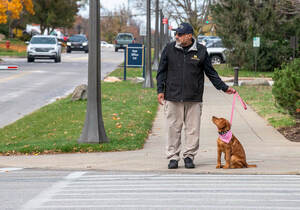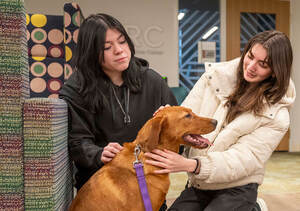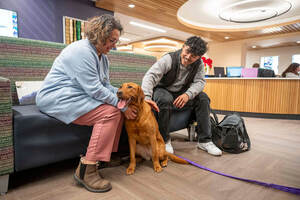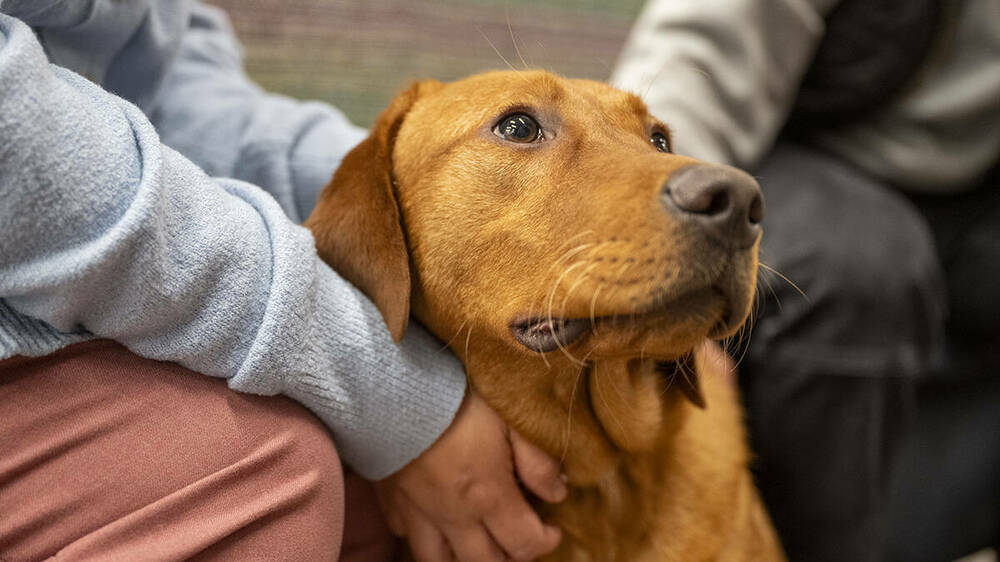The Notre Dame Police Department has a relatively new member, and you may have seen her around. She’s a beautiful redhead with big, dark eyes. If you ask politely, she might let you scratch her behind her ears. Órla, the comfort K-9, is NDPD’s first therapy dog. She’s been around campus since October, when she was a 4-month-old puppy attending football games, mingling with fans and learning the ropes. And she is already making an impact.
“There are a lot of students who I’ve run into that will say, ‘Oh, there’s Órla.’ So they are aware of her existence and they know her by name. A lot of those students have dogs and they miss their dogs. It’s a comfort,” says Paul Foley, NDPD outreach and engagement/social media manager.

When the department members found out they were getting a new dog, her name was put to a vote. Órla, which is Irish for “golden princess,” aptly won out.
Órla comes to Notre Dame via Top Notch Service Dogs and Dog Training in Elkhart, Indiana. Top Notch uses Labrador retrievers, standard poodles and golden retrievers in its training programs. Órla is a fox red Labrador retriever who lives with Foley on the weekends and stays at Top Notch through the week. For Foley, who wasn’t a dog owner before, it’s been a new experience.
“Órla’s gotten me to be a little bit more — believe it or not — healthier,” Foley says. “I go on more walks because she loves to walk, so it’s been a benefit for me health-wise.”

At 9 months old, Órla’s already working but still has some distance to cover as far as training. To be where she needs to be will take an additional nine to 15 months. Much like any other employee, Órla works during the day, even though her day may be as long as 12 hours — but it’s not without perks, such as an hour-long nap when she needs it.
Christina Gates, Órla’s Top Notch trainer, explains that this work becomes their life. “She’s been doing this since she’s been 8 days old. They get used to getting up and coming to work every day and being with a lot of people,” Gates says. “It’s not like you’re taking your family dog who’s not used to a lot of people and then saying, ‘Pet this dog.’ This is Órla’s life. This is what she enjoys doing.”
Comfort dogs like Órla might work until the age of 12 or 13 years old; some of them might end their careers earlier. “If you start seeing they’re not enjoying it anymore or if it’s hard for them, then they may retire sooner, but they work at least to the age of 9 or 10,” Gates says.
In addition to adjusting to the people on campus, Órla has adjusted to the other sights and sounds such as a fire truck going by. This is all part of her training.

“I don’t believe just any dog is suited for this,” Gates says. “We have specific breeders that we’ve worked with that do a lot of training with the females and the males that they breed. And then when the puppies are born, we start with them. By day three they’re doing cool stuff. But not every dog enjoys therapy work.
“When we were looking for Órla, she was an outgoing puppy. She was spunky. And I knew in this environment, NDPD needed a dog that could handle a lot. Not every dog is suited, but Órla is.”
While Órla is enjoying the attention from students, faculty and staff on campus, she also is an employee with a job to do. And that job could involve working with individuals who have experienced trauma. Órla’s training for those situations began when she was 8 weeks old.
“Between 8 weeks and 16 weeks, they’re like little sponges,” Gates explains. “That’s when their brains take little pictures of all the situations that they’re in.”

This was why it was important for Foley to bring Órla to some of the busiest events on campus: football games. “We knew she would be bombarded by hundreds of people and we wanted to make sure she was comfortable with that. So, 10 people to Órla now is nothing.”
In a crisis situation, the dogs are trained to enter the room and assess what is needed. Because each situation and person is different, Órla will go where she determines she is needed and stay to provide comfort and care to that person. “She will be utilized in mental health situations and for community outreach,” Foley says.
Foley, who is also going through training for the care of Órla, has a plan to make sure she is safe under conditions that require officers to respond.

And when she’s in situations that don’t involve a crisis, Órla still brings the mood up in the room. Foley emphasizes that Órla is not just for the police department, but also for the campus community. When she’s completed her training, other departments on campus will be able to request a visit from Órla.
If you see Órla out and about, it’s OK to approach her, but ask first for permission to pet her. Órla is very playful and has enjoyed people since being a puppy, but this is part of her training. “What we’d like is for her to keep her paws on the ground to be petted,” Foley says.
“She has just a really good personality for what fits here.”
